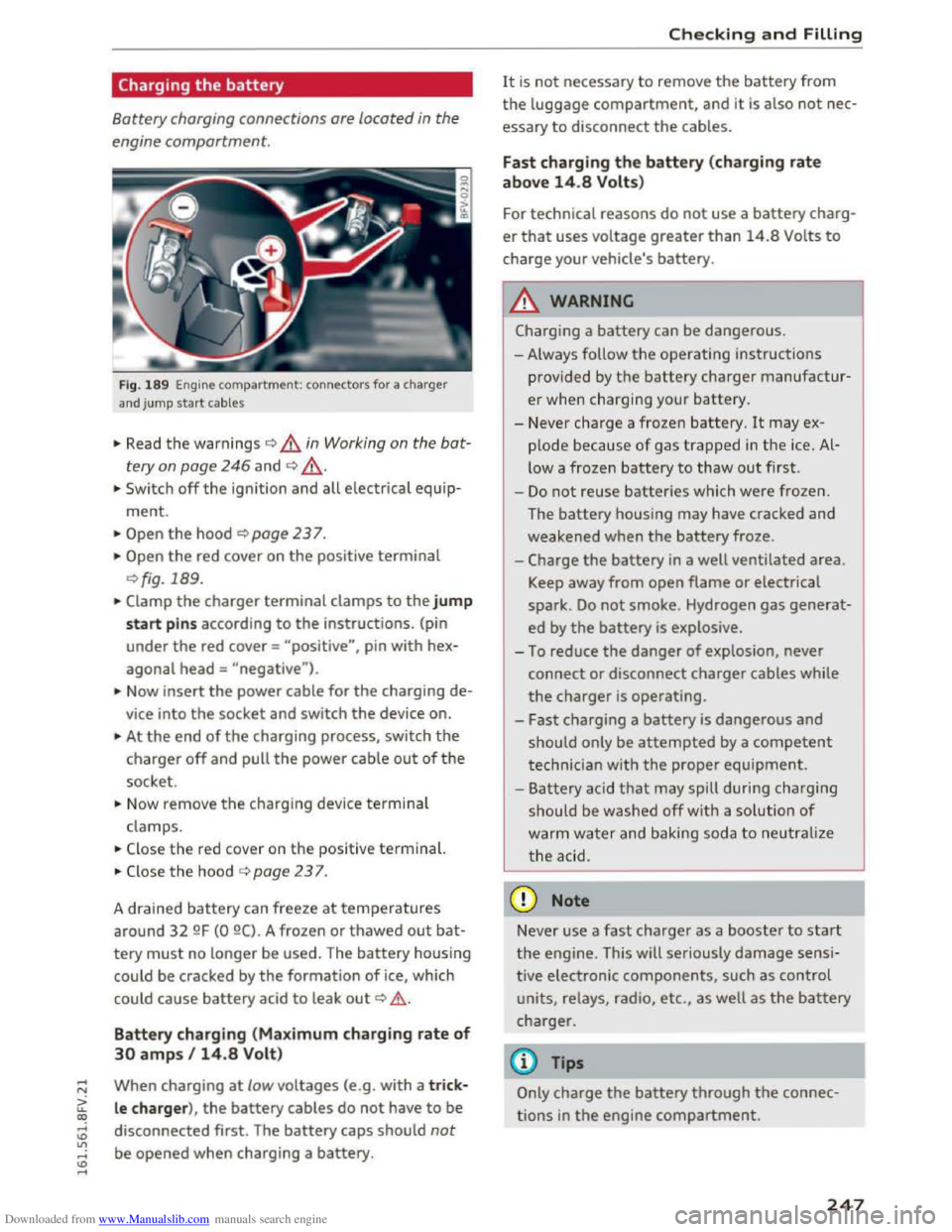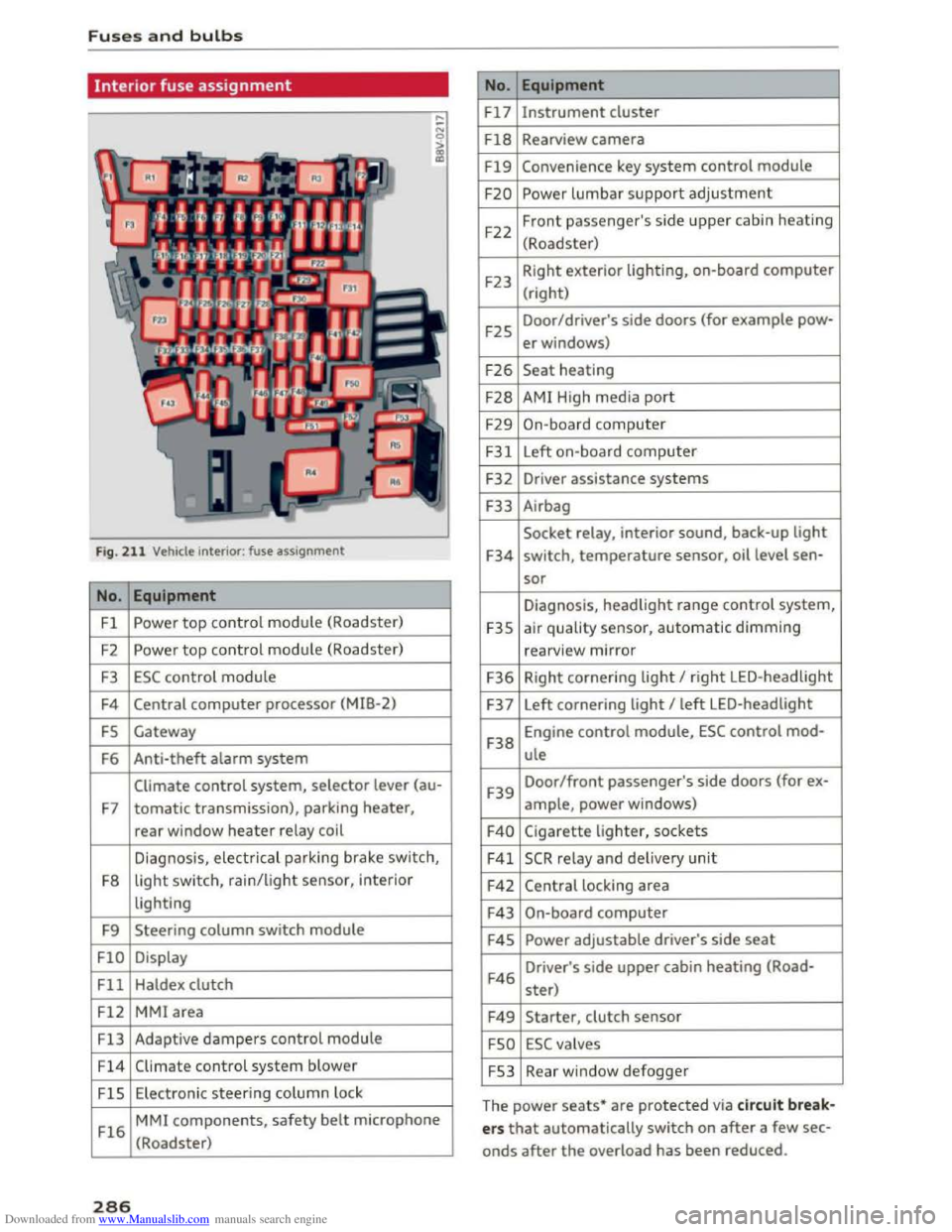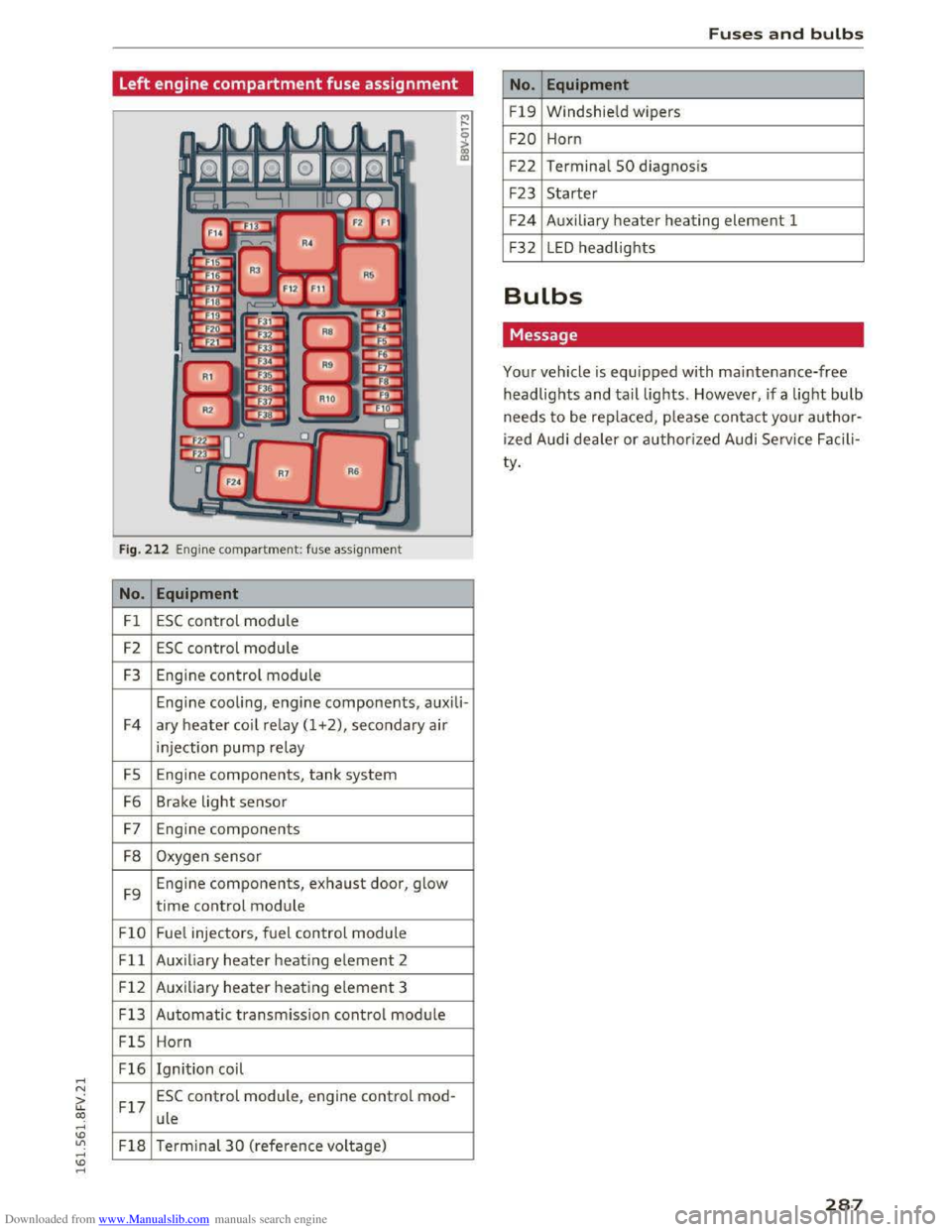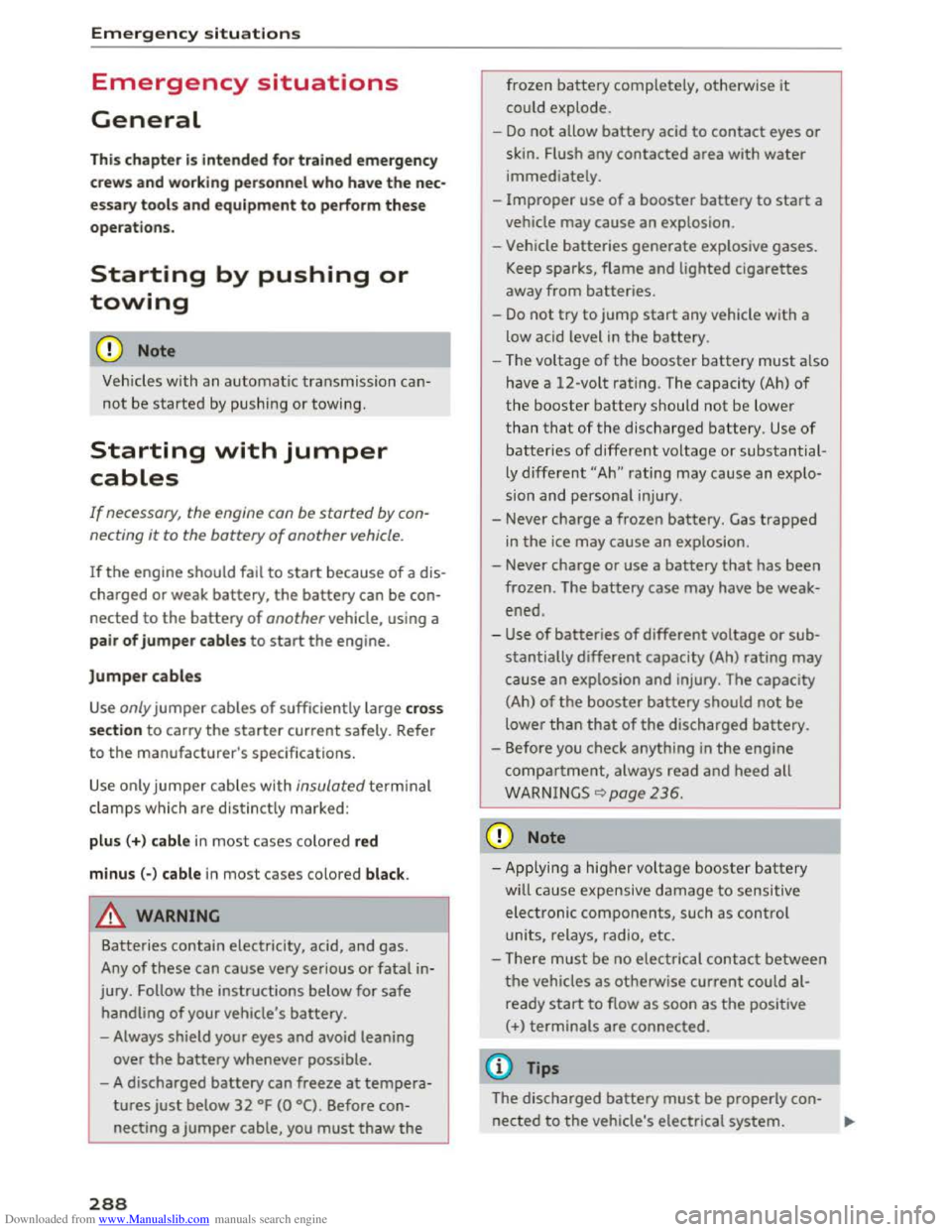relay AUDI TT COUPE 2016 Owners Manual
[x] Cancel search | Manufacturer: AUDI, Model Year: 2016, Model line: TT COUPE, Model: AUDI TT COUPE 2016Pages: 322, PDF Size: 52.86 MB
Page 249 of 322

Downloaded from www.Manualslib.com manuals search engine Charging the battery
Battery charging connections are located in the
engine comportment.
Fig . 189 Engine compartment: connectors for a charger
and jump start cables
• Read the warnings ~,&.in Working on the bat
tery on page 246 and ~ ,&..
•Switch off the ignition and all electrical equip
ment.
• Open the hood ~page 23 7.
• Open the red cover on the positive terminal
~fig. 189.
•Clamp the charger terminal clamps to the jump
start pins according to the instructions. (pin
under the red cover= "positive", pin with hex
agonal head= "negative").
•
Now insert the power cable for the charging de
vice into the socket and switch the device on.
•At the end of the charging process, switch the
charger off and pull the power cable out of the
socket.
•Now remove the charging device terminal
clamps.
• Close the red cover on the positive terminal.
•Close the hood ~page 23 7.
A drained
battery can freeze at temperatures
around 32 QF (0 QC). A frozen or thawed out bat
tery must no longer be used. The battery housing
could be cracked by
the formation of ice, which
could cause
battery acid to leak out¢& .
Battery charging (Maximum charging rate of
30 amps I 14.8 Volt)
When charging at low voltages (e.g. with a trick
le charger ), the battery cables do not have to be
disconnected first. The battery caps should not
be opened when charging a battery.
Checking and Filling
It is not necessary to remove the battery from
the luggage compartment, and it is also not nec
essary to disconnect the cables.
Fast charg ing the battery ( charging rate
above
14. 8 Volts)
For technical reasons do not use a battery charg
er that uses voltage greater than 14.8 Volts to
charge your vehicle's battery.
A WARNING
!-='"
Charging a battery can be dangerous.
-Always follow the operating instructions
provided by
the battery charger manufactur
er when charging your battery.
-Never charge a froze n battery. It may ex
plode because of gas trapped in the ice. Al
low a frozen battery to thaw out first.
-
Do not reuse batteries which were frozen.
The
battery housing may have cracked and
weakened
when the battery froze.
-
Charge the battery in a well ventilated area.
Keep away
from open flame or electrical
spark.
Do not smoke. Hydrogen gas generat
ed by the battery is explosive.
-
To reduce the danger of explosion, never
connect or disconnect charger cables while
the charger is operating.
-Fast charging a battery is dangerous and
should only be attempted by a competent
technician with the proper equipment.
-Batte ry ac id that may spill during charging
should be washed
off with a so lution of
warm water and baking soda to neutralize
t
he acid.
CD Note
Never use a fast charger as a booster to start
the engine. This will seriously damage sensi
tive electronic components, such as control
units, relays, radio,
etc., as well as the battery
charger.
Tips
Only charge the battery through the connec
tions in the engine compartment.
247
Page 288 of 322

Downloaded from www.Manualslib.com manuals search engine Fuses and bulbs
Interior fuse assignment
Fig. 211 Vehicle interior: fuse assignment
No. Equipment
Fl Powe r top control module (Roadster)
F2
Power top control module (Roadster)
F3 ESC control module
F4 Central computer processor (MIB-2)
FS Gateway
F6
Anti-theft alarm system
Climate control system, selector lever (au-
F7 tomatic transmission), parking heater,
rear window heater relay coil
Diagnosis,
electr ical parking brake switch,
F8
light switch, rain/light sensor, inter ior
lighting
F9
Steering column switch module
FlO Display
Fll Haldex clutch
F12 MMI area
Fl3 Adaptive dampers control module
F14 Climate control system blower
FlS Electronic steering column l ock
Fl6
MMI components, safety belt microphone
(Roadster)
286
No . Equipment
Fl7 Instrument cluster
Fl8 Rearview camera
F19 Convenience key system control module
F20 Power lumbar support adjustment
F22
Front passenger's side upper cabin heating
(Roadster)
F23 Right
exterior lighting, on-board computer
(right)
F25 Door/driver's
side doors (for example pow-
er windows)
F26 Seat heating
F28 AMI High media port
F29 On-board computer
F31 Left on-board computer
F32
Driver assistance systems
F33
Airbag
Socket relay, interior sound, back-up light
F34 switch, temperature sensor, oil level sen-
sor
Diagnosis, headlight range control system,
F35 air quality sensor, automatic dimming
rearview mirror
F36 Right cornering light I right LED-headlight
F37 Left
cornering light I left LED-headlight
F38
Engine control module, ESC control mod-
ule
F39
Door/front passenger's side doors (for ex-
ample, power windows)
F40 Cigarette lighter, sockets
F41 SCR relay and delivery unit
F42 Central locking area
F43 On-board computer
F45 Power adjustable driver's side seat
F46
Driver's side upper cabin heating (Road-
ster)
F49 Starter, clutch sensor
FSO ESC valves
FS3 Rear window defogger
The
power seats* are protected via circuit break
ers that automatically switch on after a few sec
onds after the overload has been reduced.
Page 289 of 322

Downloaded from www.Manualslib.com manuals search engine ..... N
G: CX)
.....
"' U"I
.....
"' .....
Left engine compartment fuse assignment
Fig. 212 Engine compartment: fuse assignment
No. Equipment
Fl ESC control module
F2 ESC control module
F3 Engine control module
Engine cooling, engine components, auxili-
F4 ary
heater coil relay (1 +2), secondary air
injection pump relay
FS Engine components, tank system
F6 Brake light sensor
F7 Engine components
F8 Oxygen sensor
F9 Engine
components, exhaust door, glow
time control module
FlO Fue
l injectors, fuel control module
Fll Auxiliary heater heating element 2
F 1 2 Auxiliary
heater heating e
lement 3
F13
Automatic transmission contr ol module
FlS Horn
F16 Ignition coil
F17
ESC control module, engine control mod-
ule
F18 Terminal 30 ( reference voltage)
Fuses and bulbs
No. Equipment
Fl9 Windshield wipers
F20 Horn
F22
Terminal 50 diagnosi s
F23 Starter
F24 Auxiliary heater heating element 1
F32 LED headlights
Bulbs
Message
Your vehicle is equipped with maintenance-free
headlights and tail lights. However, if a light bulb
needs to be replaced, please contact your author
ized Audi dealer or authorized Audi Service Facili
ty.
287
Page 290 of 322

Downloaded from www.Manualslib.com manuals search engine Emergency situations
Emergency situations
General
This chapter is intended for trained emergency
crews and working personnel who have the nec
essary tools and equipment to perform these
operations.
Starting by pushing or
towing
CD Note
Vehicles with an automatic transmission can
not be started by pushing or towi ng.
Starting with jumper
cables
If necessary, the engine con be started by con
necting it to the battery of another vehicle.
If the engine should fail to start because of a dis
charged or weak battery, the battery can be con
nected to the battery of another vehicle, using a
pair of jumper cables to start the engine.
Jumper cables
Use only jumper cables of sufficiently large cross
section to carry the starter current safely. Refer
to the manufacturer's specifications.
Use only jumper cables with insulated terminal
clamps which are distinctly marked:
plus(+) cable in most cases co lored red
minus(-) cable in most cases colored black.
A WARNING _,
Batteries contain electricity, acid, and gas.
Any of these can cause very serious or fatal in·
jury. Follow the instructions below for safe
handling of your vehicle's battery.
-Always shield your eyes and avoid leaning
over
the battery whenever possible.
- A discharged
battery can freeze at tempera
tures just below 32 °F (0 °C). Before con
necting a jumper cable, you must thaw the
288
frozen battery completely, otherwise it
could explode.
-
Do not allow battery acid to contact eyes or
skin. Flush any contacted area with water
immediately.
-
Improper use of a booster battery to start a
vehicle may
cause an explosion.
- Vehicle
batteries generate explosive gases.
Keep sparks, flame and lighted cigarettes
away from batteries.
-Do not try to jump start any vehicle with a
low acid level
in the battery.
-The voltage of th e booster battery must also
have a 12-volt rating. The capacity (Ah) of
the booster battery should not be lower
than that of the discharged battery. Use of
batteries of different voltage or substantial
ly different "Ah" rating may cause an exp lo
sion and personal injury.
- Never
charge a frozen battery. Gas trapped
in the ice may cause an explosion.
- Never
charge or use a battery that has been
frozen. The battery case may have be weak
ened.
-Use of batteries of different voltage or sub
stantially different capacity (Ah) rating may
cause an explosion and injury. The capacity
(Ah)
of the booster battery should not be
lower than that of the discharged battery.
- Before you check anything in the engine
compartment, always read and heed all
WARNINGS
~page 236.
CD Note
- Applying a higher voltage booster battery
will cause expensive damage to sensitive
electronic
components, such as control
units, relays, radio, etc.
-There must be no electrical contact between
the vehicles as otherwise current could al
ready start to flow as soon as the positive
( +
)terminals are connected.
Tips
T he discharged battery must be properly con-
nected to the vehicle's electrical system. ~